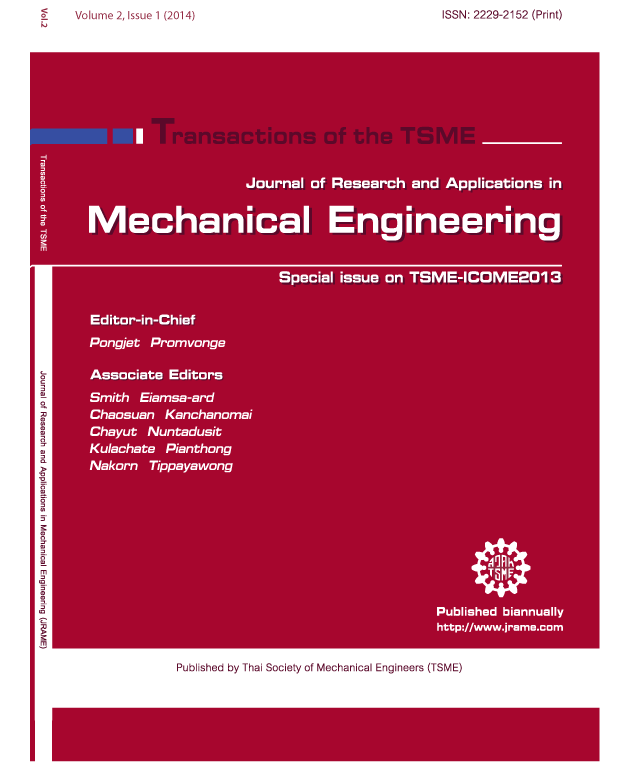The analysis of blood flow past carotid bifurcation by using the one‐way Fluid Solid Interaction technique (FSI)
Main Article Content
Abstract
This research presents the analysis of blood flow passed carotid bifurcation that are clogged with fat. Blood flow unsteadiness is due to the heart-imposed temporal variations which occur during cardiac cycle. The effects of the Newtonian and Non-Newtonian blood’s flow behavior are computed. In this study, the one way fluid–solid interaction (FSI) technique is used to calculate the flow behavior and stress distribution on blood vessel. The results can show the effects from various blood's flow analyses that provide the different wall shear stresses from computation technique. Consequentially, the tendency of potential risks that caused by the plaque rapture can be predicted more accurately and used as a supportive tool for the artery stenosis diagnosis as well.
Article Details
This work is licensed under a Creative Commons Attribution-NonCommercial-ShareAlike 4.0 International License.
References
Narrowing on Wall Shear Stress in a Coronary Artery Model with Phasic Flow, Computers and Biomedical
Research, Vol. 30, 1997, pp. 61-82.
[2] Bernsdorf, J. and Wang, D. Non-Newtonian blood flow simulation in cerebral aneurysms, Computers &
Mathematics with Applications, Vol. 58, 2009, pp. 1024-1029.
[3] Gijsen, F.J.H., Van de Vosse, F.N. and Janssen, J.D. The influence of the non-Newtonian properties of blood
on the flow in large arteries: Steady flow in a carotid bifurcation model, Journal of Biomechanics, Vol. 32,
1999, pp. 601-608.
[4] Manosh, C.P., Mamun Molla, M.D. and Roditi, G. Large-Eddy simulation of pulsatile blood flow, Medical
Engineering & Physics, Vol. 31, 2009, pp. 153-159.
[5] Barbara, M.J., Peter, R.J., Stuart, C. and David, K. Non-Newtonian blood flow in human right coronary
arteries: steady state simulations, Journal of Biomechanics, Vol. 37, 2004, pp. 709-720.
[6] Chen, J., Lu, X.Y. and Wang, W. Non-Newtonian effects of blood flow on hemodynamics in distal vascular
graft anastomoses, Journal of Biomechanics, Vol. 39, 2006, pp. 1983-1995.
[7] Abraham, J.P., Sparrow, E.M. and Lovik, R.D. Unsteady, three-dimensional fluid mechanic analysis of blood
flow in plaque-narrowed and plaque-freed arteries, International Journal of Heat and Mass Transfer, Vol. 51,
2008, pp. 5633-5641.
[8] Gijsen, F.J.H., Allanic, E., Van de Vosse, F.N. and Janssen, J.D. The influence of the non-Newtonian
properties of blood on the flow in large arteries: unsteady flow in a 90o curved tube, Journal of Biomechanics,
Vol. 32, 1999, pp. 705-713.
[9] Marques, P.F. and etc., Modeling and simulation of pulsatile blood flow with a physiologic wave pattern,
Artificial Organs, Vol. 27, 2003, pp. 478-485.
[10] Marshall, I. and etc., MRI and CFD studies of pulsatile flow in healthy and stenosed carotid bifurcation
models, Journal of Biomechanics, Vol. 37, 2004, pp. 679-687.
[11] Deplano, V. and Siou, M. Experimental and numerical study of pulsatile flows through stenosis: Wall shear
stress analysis, Journal of Biomechanics, Vol. 32, 1999, pp. 1081-1090.
[12] Bathe, K.J., Finite Element Procedures. Prentice Hall, Inc., New Jersey, 1996.
[13] Huang, H., Virmani, R., Younis, H., Burke, A.P., Kamm, R.D. and Lee, R.T. The impact of calcification on
the biomechanical stability of atherosclerotic plaques, Circulation, Vol. 103, 2001, pp. 1051-1056.
[14] Tang, D., Yang, C., Zheng, J., Woodard, P.K., Sicard, G.A., Saffitz, J.E. and Yuan, C. 3D MRI-based multicomponent
FSI models for atherosclerotic plaques, a 3-D FSI model, Ann. Biomed. Eng., Vol. 32(7), 2004.
pp. 947-960.
[15] Humphrey, J.D. Cardiovascular Solid Mechanics, Springer-Verlag, New York, 2002.
[16] Anastasiou, A.D. and etc., Modeling the effect of blood viscosity on hemodynamic factors in small bifurcated
artery, Chemical Engineering Science, Vol. 71, 2012, pp. 202-211.
[17] Kim, S. Study of Non-Newtonian Viscosity and Yield Stress of Blood in a Scanning Capillary-Tube
Rheometer, Drexel University, 2002.



